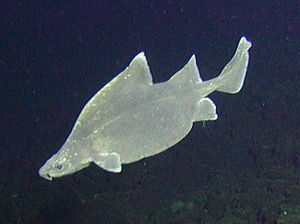Pig sharks
| Pig sharks | ||||||||||||
|---|---|---|---|---|---|---|---|---|---|---|---|---|

Prickly sea sow ( Oxynotus bruniensis ) |
||||||||||||
| Systematics | ||||||||||||
|
||||||||||||
| Scientific name of the family | ||||||||||||
| Oxynotidae | ||||||||||||
| Gill , 1872 | ||||||||||||
| Scientific name of the genus | ||||||||||||
| Oxynotus | ||||||||||||
| Rafinesque , 1810 |
The pig sharks ( Oxynotus ) are a genus of small sharks from the order of the dogfish-like (Squaliformes). In German they are also called sea pigs , sea sow sharks or rough sharks . The species of the genus live in the Mediterranean , in the western and eastern Atlantic and in the western Pacific , on continental slopes and on the continental shelf .
features
Oxynotus species have a very high-backed body with a triangular cross-section, so that there are lateral keels between the pectoral and pelvic fins . The two dorsal fins are very high. In front of both there is a strong spike, which can also be covered by the fin. The front base of the first dorsal fin can be very far forward above the gill slits. One anal fin is missing. The skin of the fish is very rough, they have luminous organs . The species reach a length of 50 centimeters to 1.50 meters.
Systematics
There are five types :
- Prickly sea sow ( Oxynotus bruniensis (Ogilby, 1893) )
- Caribbean sea sow ( Oxynotus carribaeus (Cervigón, 1961) )
- Spotted sea sow ( Oxynotus centrina (Linnaeus, 1758) )
- Japanese sea sow ( Oxynotus japonicus (Yano & Murofushi, 1985) )
- Gray sea sow ( Oxynotus paradoxus (Frade, 1929) ), also known as sailfin sea sow
The genus was introduced in 1810 by the American naturalist Constantine S. Rafinesque-Schmaltz . Type species is Squalus centrina . In 1872 the American ichthyologist Theodore Nicholas Gill established the family Oxynotidae with Oxynotus as the only genus. Phylogenetically , however, the genus is deep within the family Somniosidae . In order to come back to the monophyletic taxa required in a modern system , there is the proposal to limit the family Somniosidae to the type genus Somniosus and to place all other genera of the Somniosidae in the family Oxynotidae.
literature
- Kurt Fiedler: Textbook of Special Zoology, Volume II, Part 2: Fish . Gustav Fischer Verlag Jena, 1991, ISBN 3-334-00339-6 .
supporting documents
- ^ A b Joseph S. Nelson, Terry C. Grande, Mark VH Wilson: Fishes of the World. Wiley, Hoboken, New Jersey, 2016, ISBN 978-1118342336 . Page 76.
- ↑ Oxynotus in the Catalog of Fishes (English)
- ↑ Gavin JP Naylor, Janine N. Caira, Kirsten Jensen, Kerri AM Rosana, Nicolas Straube, Clemens Lakner: Elasmobranch Phylogeny: A Mitochondrial Estimate Based on 595 Species. Page 43 in Jeffrey C. Carrier, John A. Musick, Michael R. Heithaus: Biology of Sharks and Their Relatives (Marine Biology). Publisher: Crc Pr Inc, 2012, ISBN 1-4398-3924-7 .
- ↑ Nicolas Straube, Chenhong Li, Julien M Claes, Shannon Corrigan, Gavin Naylor: Molecular phylogeny of Squaliformes and first occurrence of bioluminescence in sharks. BMC Evolutionary Biology 15 (1): 162 August 2015, DOI: 10.1186 / s12862-015-0446-6
Web links
- Pig sharks on Fishbase.org (English)
- Integrated Taxonomic Information System Oxynotus